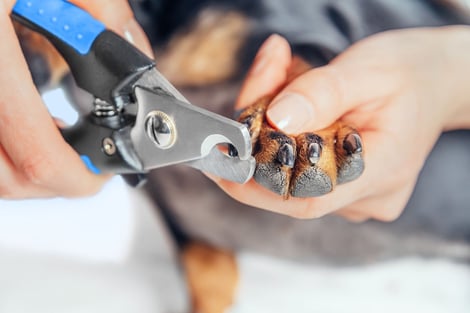
Nail trims are an important part of keeping your dog healthy, but some dogs and their owners are nervous about the process.
And it’s a skill that pet parents can — and should — learn. If nails get too long, they can be painful and lead to other health issues like deformed feet and injured tendons. And it’s usually cheaper for you to do it than asking a groomer or veterinary clinic to do it.
Dogs’ nails grow at different rates, but some vets recommend trimming nails every 3 to 4 weeks. Dogs who run on pavement need fewer nail trims than dogs that get carried around and rarely touch the ground.
Not every dog is a candidate for home trimming (some need to go to a groomer or vet), but there are some steps you can take to get a dog or puppy used to this important routine.
The experts have some excellent tips for trimming your pet’s nails, including some advice for uncooperative pets.
At-Home Nail Trimming
If you feel stressed at the thought of trimming your dog’s nails, you are not alone. Fear Free Happy Homes is an online resource for pet parents, veterinarians, and people who work with pets. They provide Fear Free certification to professionals, and they offer excellent online guides to behavioral and health topics.
In Fear Free’s video, “Nail Trims: Trimming Away the Terror," they recommend approaching the task slowly, one step at a time. Once your pet is comfortable with one aspect of the process, you can move on to the next step.
Take It One Step at a Time—with Treats
If you take things slowly, you can get your pet used to the environment and process of having you trim their nails. Like most behavioral training, it helps to have yummy, “high-value” treats handy to reward your dog as they get used to all the steps.
Step 1: Go to the Mat.
Get your pet to a nonslip surface. Some dogs learn to “go to the mat” in puppy training classes. Use treats to encourage the dog to sit, stand, or lie down on the mat.
Step 2: Smell the Nail-Trimming Tool.
Put the nail clippers or grinder or file on the ground near your dog. Let them check it out and sniff it. Give them a treat.
Step 3: Hear the Tool.
Get your pet used to the sound of clipping or grinding a nail by snipping a piece of dry pasta near your pet’s nails. If you are using a grinder, turn it on several feet away from the pet and feed them treats as you gradually move it closer to them.
Step 4: Get Them Used to Nails and Toes Being Touched.
Start high up on the dog’s shoulder or hip, and gradually move your hand down to a paw and nail. Then condition them to the sensation of a toe being gently squeezed. Give them treats every step of the way.
Step 5: Get Them Used to the Feel of the Tool.
After gently squeezing a toe to isolate the pet’s nails for clipping, you can help them feel comfortable with the feel of the clippers or grinder by holding it against the nail. Again, start at the shoulder or hip and move down. If you are using a grinder they should get used to the vibration of the grinding tool before you actually grind a nail. Repeat this several times, with treats, of course.
Step 6: Try Clipping or Grinding One Nail.
If your pet is comfortable with all the previous steps, try clipping or grinding for just a second or two, and immediately reward them with a treat.
If you are clipping:
- Pick up a paw, and firmly but gently place your thumb on the pad of the toe and your forefinger above the paw.
- Make sure your dog’s fur is not in the way.
- Extend the nail by gently pushing your thumb upward.
- Clip only the tip, straight across. Avoid the area where the nail curves.
If you are grinding:
- Ask a trainer or vet about a safe grinding tool.
- Grind a small part of your dog’s nail at a time while supporting the dog’s toe firmly but gently.
- Grind across the bottom of the nail and then carefully in from the tip of the nail, smoothing rough edges.
- Hold the grinder toward the top for better control.
Proceed only if your dog is not showing signs of stress. Feed them a treat after each nail, and thank them for being such a good dog.
The American Kennel Club (AKC) recommends a similar approach, but they advise taking a whole week before you get to the actual trimming.
More Tips for Fear-Free Nail Care
- If you are raising a puppy, get them used to having their paws and nails touched early so nail trimming won’t be as stressful as they grow up.
- Don’t rush. Even after you’ve completed all the steps, you don’t need to trim all the nails. Even one nail is a success if your dog doesn’t get stressed.
- If your pet shows signs of moderate to severe stress even after you calmly take them through all the steps, consider consulting with a groomer, a positive reinforcement trainer, a certified animal behaviorist, or your veterinarian.
- Some pets do better if they take a calming medication before nail trims.
- Some experts recommend letting a dog lick peanut butter off a silicone wall mat while you trim their nails. Make sure there’s NO XYLITOL in the peanut butter.
- Ask your vet to show you where the quick is on your dog’s paw. That’s the bit of flesh that extends under the nail. If you nick it, it will bleed. And it hurts, so your dog might be more afraid of nail trims after that.
- If you do end up cutting the quick, have some styptic powder, flour, or cornstarch handy to stop the bleeding. You’ll need to apply pressure for a while.
- There’s no doubt about it: Black nails are harder to trim than white ones. It can be hard to identify where the quick is. There is a chalk-white ring near where the quick is. You can ask a professional to show it to you.
If You Need Help
Sometimes, you simply cannot clip your dog's nails at home. This could be for a variety of reasons.
If your dog just won’t let you clip their nails, there are groomers that do this. Of course, it costs money to have someone else do it, but it may save the relationship you have with your dog. You’ll want to be sure that the groomer you choose knows how to reduce stress in your dog during the procedure.
Sometimes, you’ll need medication to give your dog to keep them as calm as possible during the procedure, regardless of whether you do it, a groomer does it, or your veterinary care team does it. You’ll need to get a prescription for these medications, which, of course, costs money.
Happy, Healthy Dogs
Keeping nails trimmed is one of the many things we do for our dogs to keep them living happy, healthy lives. If you have questions about nail trimming or any pet health issue, ask your veterinarian. They can help point you to resources that can help you meet your pet care needs.

